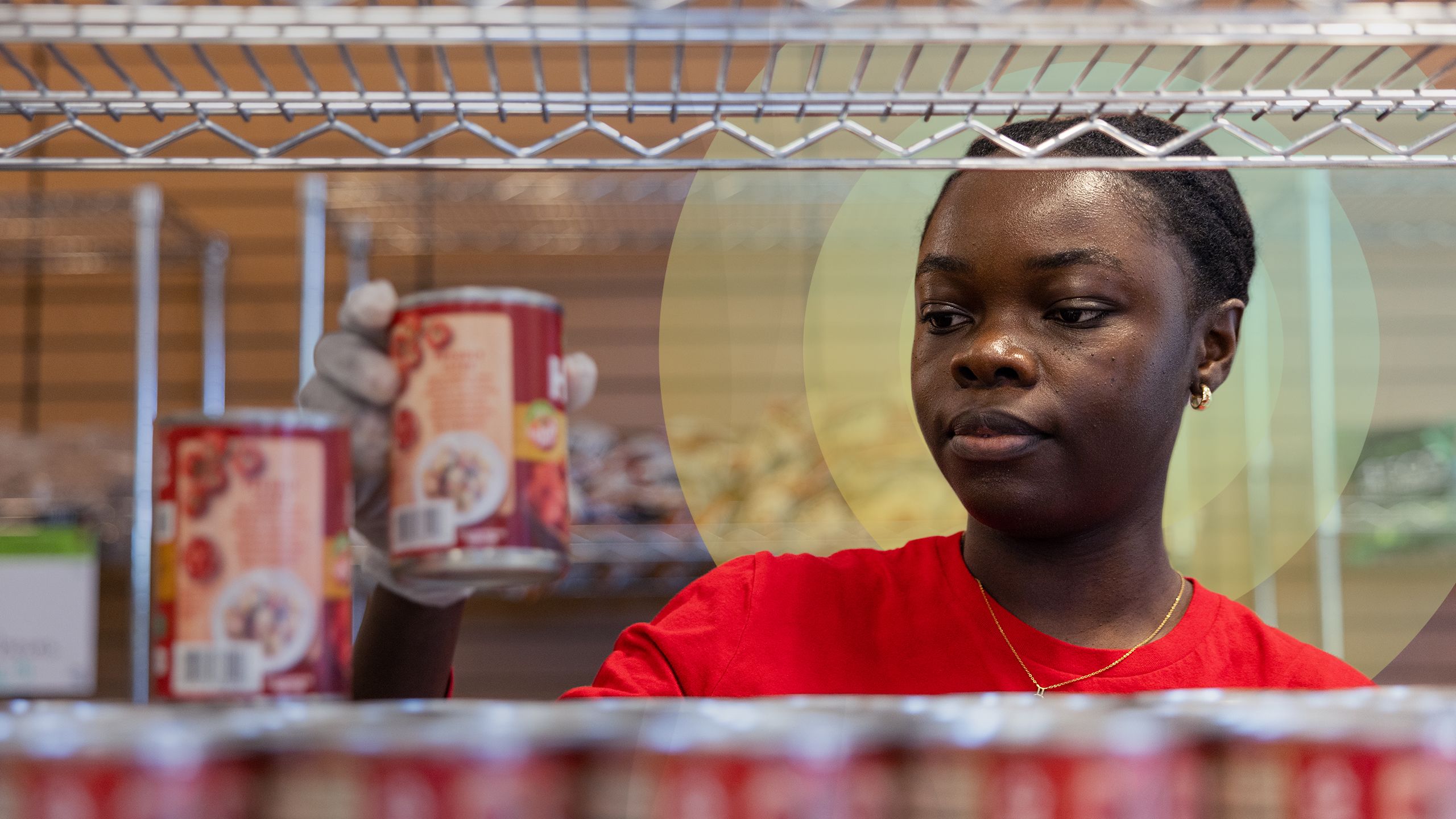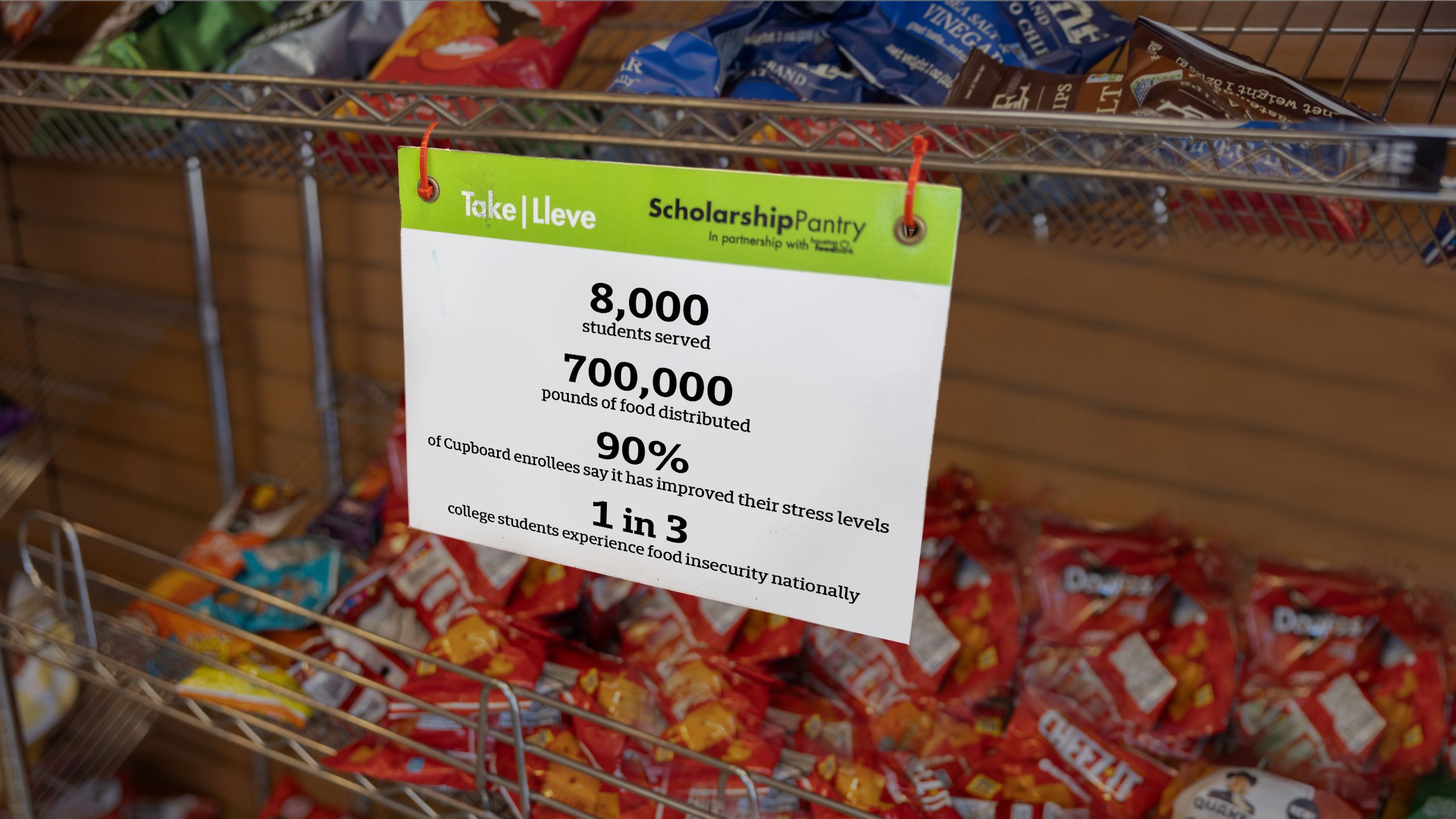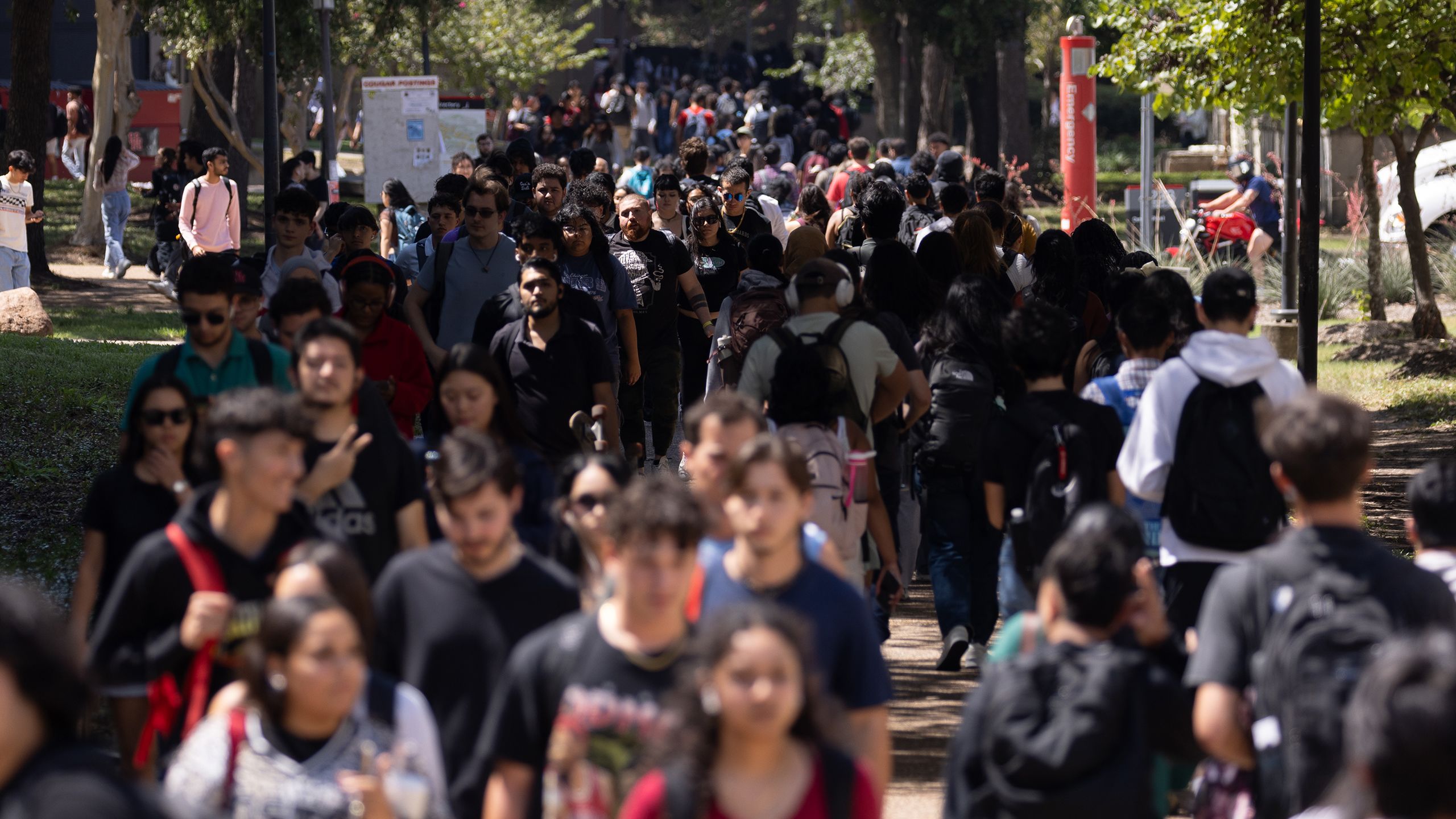Feeding Student Success
As the role of universities in students’ lives expands, UH is addressing the full spectrum of needs, from academics and finances to food insecurity and mental health.
By Shawn Shinneman

In February 2020, just one month after opening, long lines were forming at the University of Houston’s Cougar Cupboard. UH opened the small food pantry to address growing food insecurity in light of research showing just how much that can influence performance in the classroom.
Four years later, Cougar Cupboard is proving to be well worth the investment. The pantry has grown to serve some 8,000 students and distribute 700,000 pounds of food. In April 2024, it moved into a new, larger space in University Lofts to account for the growing demand.
University administrators across the country are becoming increasingly aware of how much food insecurity affects their students and impacts retention rates, and they are doing what they can to address it.
In truth, it’s not just the Cupboard where UH is boosting resources. As expectations about the role of universities expand, the school is working to address the full spectrum of students’ needs. Students perform best in the classroom when they’re able to fully engage — which means any university truly interested in getting the most out of its students must embrace the many outside-the-classroom considerations that enable a focus on studies.
“There’s enough research that tells us that if students are in an environment in which they feel supported, they’re going to perform better on all levels,” says Paul Kittle, vice president for student affairs at UH, who recently joined the University.
UH has invested in programming in health and wellness, mental health, financial health, academic support, and career prep, among other areas. But the approach isn’t just about spinning up services. It’s about a holistic rethinking of the student experience. “We’ve known for a long time that our role was more than just issuing degrees,” Kittle says. “When you’re working with people, you can’t be one-dimensional. Our students and the communities we serve are not one dimension.”
Research shows students are more likely to graduate when they have access to resources such as academic advising, financial aid services and mental health counseling. Credit: Jon Burke
Research shows students are more likely to graduate when they have access to resources such as academic advising, financial aid services and mental health counseling. Credit: Jon Burke
A New Approach to Caring for Students
It used to be that universities were expected mostly to do one thing: educate their students. But as research connecting student services with outcomes has grown, many colleges are reconsidering their role in a student’s life.
“Resources such as academic advising, financial aid services and mental health counseling can mean the difference between stopping out and graduating,” the Lumina Foundation noted. Its research collaborator Tyton Partners found that students who know about support services “report higher rates of feeling like they belong at their college or university.”
There is no panacea for students’ wide-ranging needs. It takes a cohesive plan to keep students healthy and enable their success.
“When we started to have a mental health crisis 10 or 12 years ago, everyone thought we should just hire more counselors,” Kittle says. “Well, we couldn’t build a counseling center big enough or have enough counselors to out-staff this issue. So we really look at creating the culture from a multifaceted view — whether it’s going to be mental health, academic needs, personal development, financial, physical movement or career prep. All those elements have to be part of the culture.”
There are the nuts-and-bolts services such as group and individual counseling, physical health and nutrition programming, financial literacy education, tutoring, spiritual and religious resources, and others. But enabling success requires thinking outside the box. It means going upstream to pinpoint and alleviate stressors.
Centennial Plaza, set to open in 2027, is designed to be a place where students can come to socialize and decompress. Credit: OJB
Centennial Plaza, set to open in 2027, is designed to be a place where students can come to socialize and decompress. Credit: OJB
Kittle says UH’s Centennial Plaza, in development for the University’s centennial celebration in 2027, is a perfect example. It will be an open green space with flowing water, shade, tables and chairs, and room for tossing a Frisbee or hanging out with peers. It’s the sort of space for decompression that, Kittle hopes, will lead to an overall happier student body.
There are smaller efforts too. UH now educates professors on simple things like when papers and projects should be due, for instance. Midnight deadlines beget tired students, and moving them up a few hours to 8 p.m. can make a small, but not insignificant, difference.
Then there are the folks tasked with ensuring young people on campus understand the resources available to them. More than 35% of students who responded to the Tyton-led study said they weren’t aware of critical support offered by their respective schools. One way UH addresses that gap is to make sure staff and faculty are up to speed on what the school offers outside the classroom.
The first four to six weeks of the college experience are a good indicator of how a student is adjusting both socially and academically. To get students in touch with resources earlier, residence halls now have a team of five called the Student Success and Wellness Team, which works together with Academic Success. The team is equipped with early-intervention strategies.
“We know we can’t be predictive, and we certainly don’t want to stereotype,” Kittle says. “Students are going to need different things. It’s about not only having a good menu of resources and support, but also having the network that’s educated about them and that works collaboratively.”
That holistic approach also has a way of creating equity, helping students from all backgrounds get the support they need.
“I’ve worked with students from privileged backgrounds who didn’t need financial assistance but still required a lot of other support,” Kittle says. “And I’ve worked with students from the lowest income bracket who may have needed support on that side but were well-adjusted socially.”

In February 2020, just one month after opening, long lines were forming at the University of Houston’s Cougar Cupboard. UH opened the small food pantry to address growing food insecurity in light of research showing just how much that can influence performance in the classroom.
Four years later, Cougar Cupboard is proving to be well worth the investment. The pantry has grown to serve some 8,000 students and distribute 700,000 pounds of food. In April 2024, it moved into a new, larger space in University Lofts to account for the growing demand.
University administrators across the country are becoming increasingly aware of how much food insecurity affects their students and impacts retention rates, and they are doing what they can to address it.
In truth, it’s not just the Cupboard where UH is boosting resources. As expectations about the role of universities expand, the school is working to address the full spectrum of students’ needs. Students perform best in the classroom when they’re able to fully engage — which means any university truly interested in getting the most out of its students must embrace the many outside-the-classroom considerations that enable a focus on studies.
“There’s enough research that tells us that if students are in an environment in which they feel supported, they’re going to perform better on all levels,” says Paul Kittle, vice president for student affairs at UH, who recently joined the University.
UH has invested in programming in health and wellness, mental health, financial health, academic support, and career prep, among other areas. But the approach isn’t just about spinning up services. It’s about a holistic rethinking of the student experience. “We’ve known for a long time that our role was more than just issuing degrees,” Kittle says. “When you’re working with people, you can’t be one-dimensional. Our students and the communities we serve are not one dimension.”
Research shows students are more likely to graduate when they have access to resources such as academic advising, financial aid services and mental health counseling. Credit: Jon Burke
Research shows students are more likely to graduate when they have access to resources such as academic advising, financial aid services and mental health counseling. Credit: Jon Burke
A New Approach to Caring for Students
It used to be that universities were expected mostly to do one thing: educate their students. But as research connecting student services with outcomes has grown, many colleges are reconsidering their role in a student’s life.
“Resources such as academic advising, financial aid services and mental health counseling can mean the difference between stopping out and graduating,” the Lumina Foundation noted. Its research collaborator Tyton Partners found that students who know about support services “report higher rates of feeling like they belong at their college or university.”
There is no panacea for students’ wide-ranging needs. It takes a cohesive plan to keep students healthy and enable their success.
“When we started to have a mental health crisis 10 or 12 years ago, everyone thought we should just hire more counselors,” Kittle says. “Well, we couldn’t build a counseling center big enough or have enough counselors to out-staff this issue. So we really look at creating the culture from a multifaceted view — whether it’s going to be mental health, academic needs, personal development, financial, physical movement or career prep. All those elements have to be part of the culture.”
There are the nuts-and-bolts services such as group and individual counseling, physical health and nutrition programming, financial literacy education, tutoring, spiritual and religious resources, and others. But enabling success requires thinking outside the box. It means going upstream to pinpoint and alleviate stressors.
Centennial Plaza, set to open in 2027, is designed to be a place where students can come to socialize and decompress. Credit: OJB
Centennial Plaza, set to open in 2027, is designed to be a place where students can come to socialize and decompress. Credit: OJB
Kittle says UH’s Centennial Plaza, in development for the University’s centennial celebration in 2027, is a perfect example. It will be an open green space with flowing water, shade, tables and chairs, and room for tossing a Frisbee or hanging out with peers. It’s the sort of space for decompression that, Kittle hopes, will lead to an overall happier student body.
There are smaller efforts too. UH now educates professors on simple things like when papers and projects should be due, for instance. Midnight deadlines beget tired students, and moving them up a few hours to 8 p.m. can make a small, but not insignificant, difference.
Then there are the folks tasked with ensuring young people on campus understand the resources available to them. More than 35% of students who responded to the Tyton-led study said they weren’t aware of critical support offered by their respective schools. One way UH addresses that gap is to make sure staff and faculty are up to speed on what the school offers outside the classroom.
The first four to six weeks of the college experience are a good indicator of how a student is adjusting both socially and academically. To get students in touch with resources earlier, residence halls now have a team of five called the Student Success and Wellness Team, which works together with Academic Success. The team is equipped with early-intervention strategies.
“We know we can’t be predictive, and we certainly don’t want to stereotype,” Kittle says. “Students are going to need different things. It’s about not only having a good menu of resources and support, but also having the network that’s educated about them and that works collaboratively.”
That holistic approach also has a way of creating equity, helping students from all backgrounds get the support they need.
“I’ve worked with students from privileged backgrounds who didn’t need financial assistance but still required a lot of other support,” Kittle says. “And I’ve worked with students from the lowest income bracket who may have needed support on that side but were well-adjusted socially.”
The Cougar Cupboard’s Impact
Although it's just one part of UH’s overall student services offerings, the Cougar Cupboard food pantry has a measurable influence on students’ health and well-being.

The Cougar Cupboard’s Impact
Although it's just one part of UH’s overall student services offerings, the Cougar Cupboard food pantry has a measurable influence on students’ health and well-being.
“We really look at creating the culture from a multifaceted view — mental health, academic needs, personal development, financial, physical movement, career prep. All those elements have to be part of the culture.”
— Paul Kittle, Vice President for Student Affairs

“We really look at creating the culture from a multifaceted view — mental health, academic needs, personal development, financial, physical movement, career prep. All those elements have to be part of the culture.”
— Paul Kittle, Vice President for Student Affairs

The Cougar Cupboard is set up to feel like a grocery store, making students feel comfortable and reducing stigma. Credit: Jon Burke
The Cougar Cupboard is set up to feel like a grocery store, making students feel comfortable and reducing stigma. Credit: Jon Burke
A New Home for Cougar Cupboard
It didn't take long for the University to realize that Cougar Cupboard would need more space.
As soon as it opened, lines were already weaving throughout the “little back-off ice pantry,” says Michael Crook, director of the Center for Student Advocacy and Community. Numbers increased steadily over the next several years, with periods of explosive growth. By fall enrollment in 2022, for instance, demand had nearly doubled, with 1,000 student visitors in August compared to 550 visitors during the entire previous spring semester.
The Cupboard had taken on additional space next door, but the need for something larger was clear. Lines began spilling out of the office and across the lobby of the Campus Recreation and Wellness Center. It was about two years ago that conversations about a move began.
Student housing supported the facility by providing a discount on the larger space. After construction, the Cupboard began moving in last year and officially opened its doors in April 2024.
“It’s been a journey,” Crook says. “Both the staff who helped create the Cupboard and our students were waiting and patient a long time. And we’re so grateful, because the space is amazing.”
The experience now feels more like that of a grocery store. “That’s really important because of the stigma,” Crook says. “We’ve had students write to us saying that they felt ashamed or emotional or hesitant to use a food pantry for the first time.”
The new, expanded Cougar Cupboard opened its doors in April 2024. Credit: Jon Burke
The new, expanded Cougar Cupboard opened its doors in April 2024. Credit: Jon Burke
Creating Better Student Outcomes
Crook says accounting for food insecurity on campus is one of the most important things a university can do. When Cougar Cupboard polls its enrollees as they sign up, 38% say they’ve considered leaving the University due to financial stress. Meanwhile, national studies say about 1 in 3 college students are experiencing food insecurity. “That alone speaks to the relationship between retention and food insecurity,” Crook says.
The stress of not knowing where your next meal is coming from can be immense. Crook says some students are making choices between feeding themselves and paying tuition, buying essentials or providing for their households. Meanwhile, there is nothing easy about studying on an empty stomach. Take it all together, and there’s a reason that 90% of Cupboard enrollees say the pantry has helped improve their stress levels.
More broadly across campus, the focus on student success appears to be working. The graduation rate for at-risk students — those who’ve received Pell Grants or are f irst-time college-goers — is now roughly the same as their peers, UH President Renu Khator wrote last year in her annual State of the University address. UH has had more success than most in closing that performance gap.
And there are additional indicators. UH polls its students on things like their sense of belonging and how safe they feel on campus. Responses, Kittle says, have been trending up.
“Students have to know that we care about them at a level that is more than just a transaction of, ‘Pay us and you’re getting a degree,’” Kittle says. “It’s about creating a holistic culture of caring for our students. We’ve got enough research that tells us they’re going to perform better, they’re going to be better prepared when they leave and they’re going to impact their communities at a higher level.”

The Cougar Cupboard is set up to feel like a grocery store, making students feel comfortable and reducing stigma. Credit: Jon Burke
The Cougar Cupboard is set up to feel like a grocery store, making students feel comfortable and reducing stigma. Credit: Jon Burke
A New Home for Cougar Cupboard
It didn't take long for the University to realize that Cougar Cupboard would need more space.
As soon as it opened, lines were already weaving throughout the “little back-off ice pantry,” says Michael Crook, director of the Center for Student Advocacy and Community. Numbers increased steadily over the next several years, with periods of explosive growth. By fall enrollment in 2022, for instance, demand had nearly doubled, with 1,000 student visitors in August compared to 550 visitors during the entire previous spring semester.
The Cupboard had taken on additional space next door, but the need for something larger was clear. Lines began spilling out of the office and across the lobby of the Campus Recreation and Wellness Center. It was about two years ago that conversations about a move began.
Student housing supported the facility by providing a discount on the larger space. After construction, the Cupboard began moving in last year and officially opened its doors in April 2024.
“It’s been a journey,” Crook says. “Both the staff who helped create the Cupboard and our students were waiting and patient a long time. And we’re so grateful, because the space is amazing.”
The experience now feels more like that of a grocery store. “That’s really important because of the stigma,” Crook says. “We’ve had students write to us saying that they felt ashamed or emotional or hesitant to use a food pantry for the first time.”
The new, expanded Cougar Cupboard opened its doors in April 2024. Credit: Jon Burke
The new, expanded Cougar Cupboard opened its doors in April 2024. Credit: Jon Burke
Creating Better Student Outcomes
Crook says accounting for food insecurity on campus is one of the most important things a university can do. When Cougar Cupboard polls its enrollees as they sign up, 38% say they’ve considered leaving the University due to financial stress. Meanwhile, national studies say about 1 in 3 college students are experiencing food insecurity. “That alone speaks to the relationship between retention and food insecurity,” Crook says.
The stress of not knowing where your next meal is coming from can be immense. Crook says some students are making choices between feeding themselves and paying tuition, buying essentials or providing for their households. Meanwhile, there is nothing easy about studying on an empty stomach. Take it all together, and there’s a reason that 90% of Cupboard enrollees say the pantry has helped improve their stress levels.
More broadly across campus, the focus on student success appears to be working. The graduation rate for at-risk students — those who’ve received Pell Grants or are f irst-time college-goers — is now roughly the same as their peers, UH President Renu Khator wrote last year in her annual State of the University address. UH has had more success than most in closing that performance gap.
And there are additional indicators. UH polls its students on things like their sense of belonging and how safe they feel on campus. Responses, Kittle says, have been trending up.
“Students have to know that we care about them at a level that is more than just a transaction of, ‘Pay us and you’re getting a degree,’” Kittle says. “It’s about creating a holistic culture of caring for our students. We’ve got enough research that tells us they’re going to perform better, they’re going to be better prepared when they leave and they’re going to impact their communities at a higher level.”







